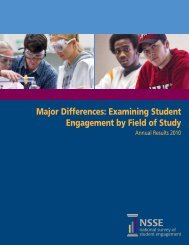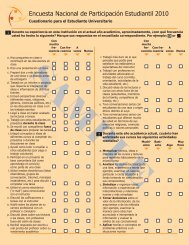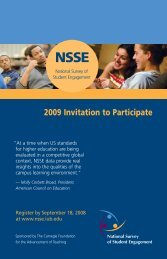Conceptual Framework and Overview of Psychometric Properties
Conceptual Framework and Overview of Psychometric Properties
Conceptual Framework and Overview of Psychometric Properties
You also want an ePaper? Increase the reach of your titles
YUMPU automatically turns print PDFs into web optimized ePapers that Google loves.
<strong>Overview</strong> <strong>and</strong> Content <strong>of</strong> the NSSEProject <strong>and</strong> QuestionnaireThe National Survey <strong>of</strong> Student Engagement(NSSE) is specifically designed to assess theextent to which students are engaged inempirically derived good educationalpractices <strong>and</strong> what they gain from theircollege experience (Kuh, 2001). The maincontent <strong>of</strong> the NSSE instrument, The CollegeStudent Report, represents student behaviorsthat are highly correlated with many desirablelearning <strong>and</strong> personal development outcomes<strong>of</strong> college. Responding to the questionnairerequires that students reflect on what they areputting into <strong>and</strong> getting out <strong>of</strong> their collegeexperience. Thus, completing the survey itselfis consistent with effective educationalpractice.The results from the NSSE project have beenused to produce a set <strong>of</strong> national benchmarks<strong>of</strong> good educational practice that participatingschools are using to estimate the efficacy <strong>of</strong>their improvement efforts (Kuh, 2001). Forexample, administrators <strong>and</strong> faculty membersat dozens <strong>of</strong> schools are using their NSSEresults to discover patterns <strong>of</strong> student-facultyinteractions <strong>and</strong> the frequency <strong>of</strong> studentparticipation in other educational practicesthat they can influence directly <strong>and</strong> indirectlyto improve student learning. In addition, somestates are using NSSE data in theirperformance indicator systems <strong>and</strong> for otherpublic accountability functions.Structure <strong>of</strong> the InstrumentThe College Student Report asks students toreport the frequency with which they engagein dozens <strong>of</strong> activities that represent goodeducational practice, such as using theinstitution's human resources, curricularprograms, <strong>and</strong> other opportunities for learning<strong>and</strong> development that the college provides.Additional items assess the amount <strong>of</strong> reading<strong>and</strong> writing students did during the currentschool year, the number <strong>of</strong> hours per weekthey devoted to schoolwork, extracurricularactivities, employment, <strong>and</strong> family matters,<strong>and</strong> the nature <strong>of</strong> their examinations <strong>and</strong>coursework. Seniors report whether theyparticipated in or took advantage <strong>of</strong> suchlearning opportunities as being a part <strong>of</strong> alearning community, working with a facultymember on a research project, internships,community service, <strong>and</strong> study abroad. Firstyearstudents indicate whether they have doneor plan to do these things. Students alsorecord their perceptions <strong>of</strong> features <strong>of</strong> thecollege environment that are associated withachievement, satisfaction, <strong>and</strong> persistenceincluding the extent to which the institution<strong>of</strong>fers the support students need to succeedacademically <strong>and</strong> the quality <strong>of</strong> relationsbetween various groups on campus such asfaculty <strong>and</strong> students (Astin, 1993; Pascarella& Terenzini, 1991; Tinto, 1993). Then,students estimate their educational <strong>and</strong>personal growth since starting college in theareas <strong>of</strong> general knowledge, intellectual skills,written <strong>and</strong> oral communication skills,personal, social <strong>and</strong> ethical development, <strong>and</strong>vocational preparation. These estimates aremindful <strong>of</strong> a value-added approach tooutcomes assessment whereby students makejudgments about the progress or gains theyhave made (Pace, 1984). Direct measures <strong>of</strong>student satisfaction are obtained from twoquestions: "How would you evaluate yourentire educational experience at thisinstitution?" "If you could start over again,would you go to the same institution you arenow attending?"Students also provide information about theirbackground, including age, gender, race orethnicity, living situation, educational status,<strong>and</strong> major field. Finally, up to 20 additionalquestions can be added to obtain informationspecific to an institutional consortium.Schools have the option <strong>of</strong> linking theirstudents' responses with their owninstitutional data base in order to examineother aspects <strong>of</strong> the undergraduate experience<strong>Framework</strong> & <strong>Psychometric</strong> <strong>Properties</strong>Page 2 <strong>of</strong> 26



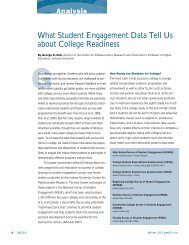

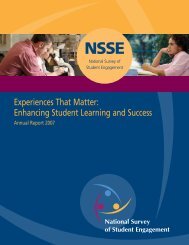
![Cuestionario para el Estudiante Universitarioâ[consent] - NSSE](https://img.yumpu.com/41728892/1/190x245/cuestionario-para-el-estudiante-universitarioaconsent-nsse.jpg?quality=85)
